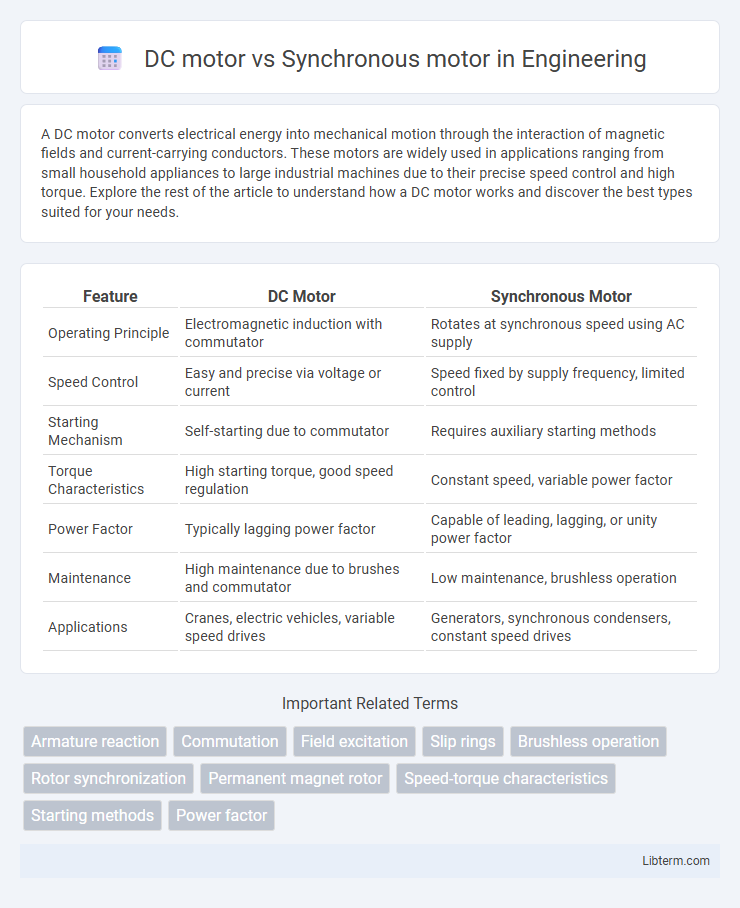A DC motor converts electrical energy into mechanical motion through the interaction of magnetic fields and current-carrying conductors. These motors are widely used in applications ranging from small household appliances to large industrial machines due to their precise speed control and high torque. Explore the rest of the article to understand how a DC motor works and discover the best types suited for your needs.
Table of Comparison
| Feature | DC Motor | Synchronous Motor |
|---|---|---|
| Operating Principle | Electromagnetic induction with commutator | Rotates at synchronous speed using AC supply |
| Speed Control | Easy and precise via voltage or current | Speed fixed by supply frequency, limited control |
| Starting Mechanism | Self-starting due to commutator | Requires auxiliary starting methods |
| Torque Characteristics | High starting torque, good speed regulation | Constant speed, variable power factor |
| Power Factor | Typically lagging power factor | Capable of leading, lagging, or unity power factor |
| Maintenance | High maintenance due to brushes and commutator | Low maintenance, brushless operation |
| Applications | Cranes, electric vehicles, variable speed drives | Generators, synchronous condensers, constant speed drives |
Introduction to DC Motors and Synchronous Motors
DC motors convert direct current electrical energy into mechanical energy using a commutator and brushes to maintain torque and speed control, making them ideal for variable speed applications. Synchronous motors operate at a constant speed synchronized with the supply frequency, leveraging a rotor with permanent magnets or electromagnets to maintain precise speed control and efficient power factor correction. Both motor types play critical roles in industrial automation, robotics, and power generation, with DC motors favored for adjustable speed and synchronous motors optimized for consistent speed and high efficiency.
Basic Working Principles Explained
A DC motor operates on the principle of electromagnetic induction, where a direct current supplied to the armature winding generates a magnetic field that interacts with the stator's magnetic field, producing rotational motion. In contrast, a synchronous motor runs at a constant speed synchronous with the supply frequency, using a rotating magnetic field from the stator and a rotor magnet or field winding that locks into this field to maintain synchronized rotation. The key difference lies in the DC motor's variable speed controlled by armature voltage or field current, whereas the synchronous motor's speed depends strictly on the supply frequency.
Construction Differences
DC motors feature a rotor consisting of windings connected to a commutator and brushes, enabling direct current supply and continuous torque production. Synchronous motors have a rotor equipped with either permanent magnets or field windings energized by DC supply, maintaining rotor speed synchronized with the stator's rotating magnetic field. The stator in both motors contains three-phase windings, but the absence of a commutator in synchronous motors results in reduced mechanical wear and higher efficiency.
Power Supply Requirements
DC motors require a constant direct current (DC) power supply, often sourced from batteries or DC power converters, enabling precise speed control through voltage variation. Synchronous motors operate on alternating current (AC) power at a fixed frequency, relying on an external power source to create a rotating magnetic field for rotor synchronization. The power supply for synchronous motors demands stable frequency and voltage to maintain consistent rotor speed and torque output.
Speed Control and Regulation
DC motors provide precise speed control through varying armature voltage or field current, enabling smooth adjustments over a wide range. Synchronous motors maintain constant speed regulated by the supply frequency, making speed variation less flexible and typically requiring power electronics for adjustable-speed drive applications. Speed regulation in DC motors offers superior dynamic response compared to the fixed-speed characteristic inherent in synchronous motors.
Efficiency and Performance Comparison
DC motors typically exhibit higher starting torque and simpler speed control but often suffer from lower efficiency due to brush and commutator losses. Synchronous motors offer superior efficiency and power factor correction, especially at constant speed in industrial applications, because they operate without brushes and have synchronous speed operation. Performance-wise, synchronous motors excel in precision and energy savings during continuous operation, whereas DC motors provide better dynamic response and ease of control in variable speed scenarios.
Applications in Industry
DC motors excel in variable speed control applications such as conveyors, hoists, and electric vehicles, providing precise torque and speed regulation ideal for manufacturing and automation. Synchronous motors are preferred in industries requiring constant speed and high efficiency like pumps, compressors, and power factor correction in large-scale industrial plants. Both motor types optimize performance in distinct industrial settings based on load requirements and operational stability.
Maintenance and Reliability
DC motors require regular maintenance due to the presence of brushes and commutators, which are prone to wear and require periodic replacement. Synchronous motors offer higher reliability and lower maintenance needs since they have no brushes and use a more robust rotor design. In industrial applications, synchronous motors are preferred for long-term operation due to their durability and consistent performance.
Cost and Economic Considerations
DC motors generally have higher maintenance costs due to brushes and commutators requiring regular replacement, impacting long-term economic efficiency. Synchronous motors, while initially more expensive because of complex design and control systems, offer lower operational costs through higher efficiency and reduced energy consumption. The total cost of ownership favors synchronous motors in applications demanding continuous, stable performance despite their upfront investment.
Choosing the Right Motor for Your Needs
DC motors offer precise speed control and high starting torque, making them ideal for applications requiring variable speed and frequent starts and stops. Synchronous motors operate at a constant speed synchronized with the power supply frequency, providing high efficiency and power factor correction suitable for industrial drives and constant-speed applications. Selecting between a DC motor and a synchronous motor depends on factors like speed control requirements, load characteristics, and energy efficiency priorities.
DC motor Infographic

 libterm.com
libterm.com